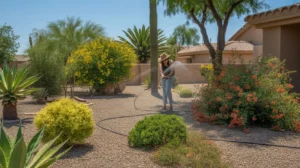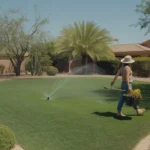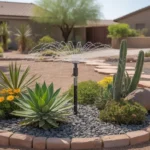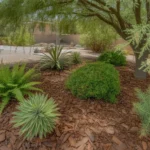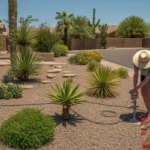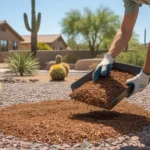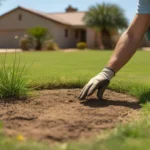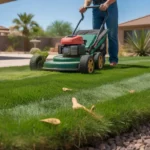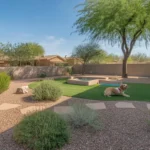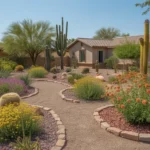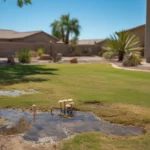As the scorching mid-summer heat settles over Chandler, it’s the perfect time to reevaluate your yard care routine. With some strategic adjustments, you can help your landscape thrive despite the intense temperatures and keep your outdoor oasis looking its best. Here are some expert tips for mid-summer yard care in Chandler.
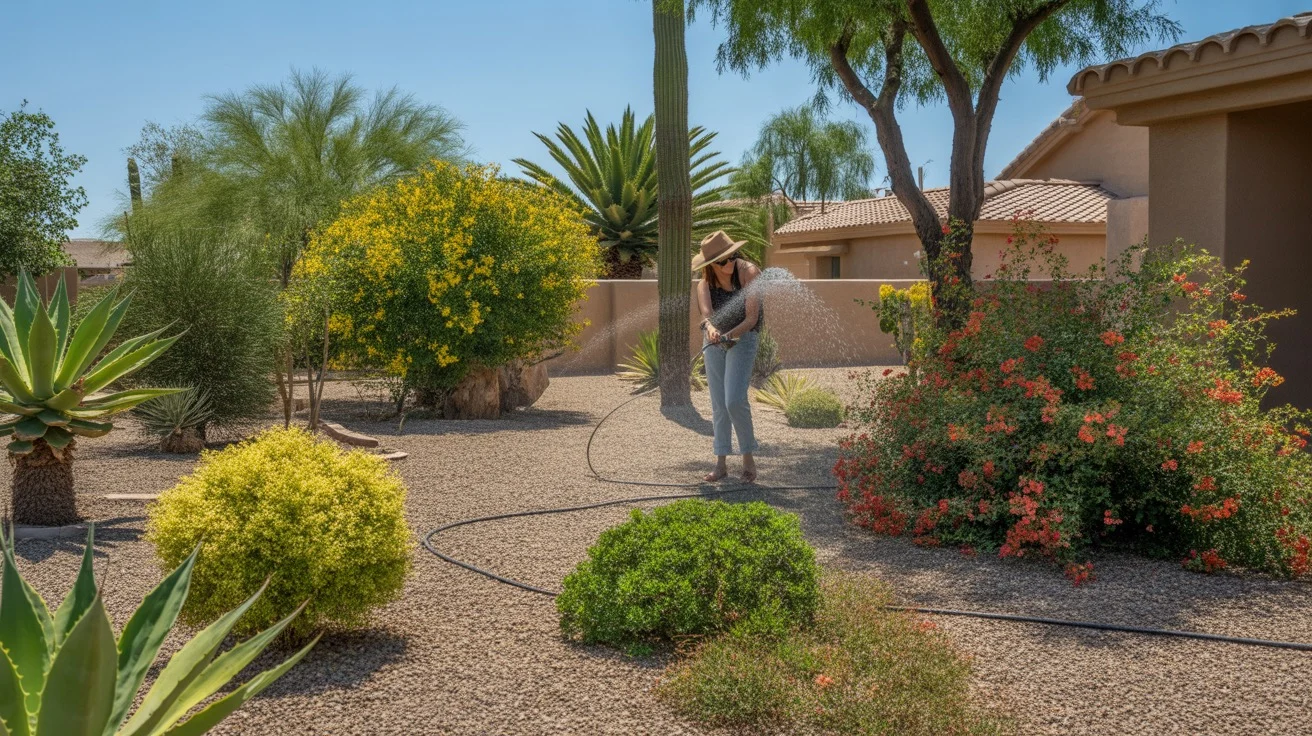
Assess Your Irrigation System
Proper watering is crucial during Chandler’s hot summer months. Take a close look at your irrigation system to ensure it’s functioning optimally. Check for leaks, clogged emitters, or broken sprinkler heads and make repairs as needed. Consider upgrading to a smart irrigation controller that automatically adjusts watering based on weather conditions to conserve water while keeping your plants hydrated.
Evaluate your watering schedule and make adjustments based on the current weather and your plants’ needs. Deep, infrequent watering encourages deeper root growth, making plants more resilient to heat and drought. Water early in the morning or late in the evening to minimize evaporation and allow the water to soak into the soil.
If you notice areas of your lawn or garden that are consistently dry or soggy, you may need to adjust your irrigation system’s coverage. Add or relocate sprinkler heads to ensure even water distribution throughout your yard. Proper irrigation is key to maintaining a healthy, lush landscape in Chandler’s demanding summer climate.
Prune and Deadhead for Optimal Growth
Mid-summer is an ideal time to prune and deadhead your plants to promote healthy growth and keep them looking tidy. Remove any dead, damaged, or diseased branches from trees and shrubs to prevent the spread of problems and improve the plant’s overall health. Prune flowering shrubs after they’ve finished blooming to encourage new growth and prepare them for the next flowering cycle.
Deadheading, or removing spent blooms, is essential for annuals and perennials. By cutting off faded flowers, you redirect the plant’s energy into producing new blooms and foliage instead of setting seed. This keeps your garden looking vibrant and colorful throughout the summer. Be sure to use clean, sharp pruning tools to avoid damaging your plants and minimize the risk of disease transmission.
Mulch to Retain Moisture and Regulate Soil Temperature
Applying a layer of organic mulch around your plants is one of the most effective ways to conserve moisture and regulate soil temperature during Chandler’s hot summer months. Mulch acts as an insulating layer, preventing rapid evaporation and keeping the soil cooler. This helps reduce water loss, minimizes temperature fluctuations, and creates a more stable environment for plant roots.
Choose a mulch that complements your landscape style, such as shredded bark, wood chips, or gravel. Apply a 2-3 inch layer around trees, shrubs, and in garden beds, keeping the mulch a few inches away from plant stems to prevent rot. As the mulch breaks down, it adds organic matter to the soil, improving its structure and fertility over time.
In addition to its practical benefits, mulch also enhances the aesthetic appeal of your yard by creating a clean, finished look. It suppresses weed growth, reducing the time and effort needed for weeding, and provides a visually pleasing contrast to your plants’ foliage and flowers.
Monitor for Pests and Diseases
The hot, dry conditions of Chandler’s mid-summer can make plants more susceptible to pests and diseases. Regularly inspect your yard for signs of infestation or illness, such as discolored leaves, wilting, or unusual insect activity. Common summer pests in Chandler include aphids, whiteflies, and spider mites, while fungal diseases like powdery mildew can also take hold in the heat.
If you spot a problem, act quickly to prevent it from spreading. For minor pest infestations, try natural control methods first, such as handpicking insects or using a strong spray of water to dislodge them. If necessary, use targeted, organic pesticides to minimize the impact on beneficial insects. Fungal diseases can often be managed by improving air circulation around affected plants and avoiding overhead watering.
Maintaining a diverse, healthy yard is one of the best ways to prevent pest and disease problems. By selecting well-adapted, resilient plants and providing them with proper care, you create an environment that is less hospitable to pests and more resistant to disease.
Refresh Potted Plants and Container Gardens
Potted plants and container gardens can add a beautiful, versatile element to your Chandler yard, but they require extra attention during the hot summer months. The limited soil volume in containers dries out more quickly than in-ground beds, so you may need to water your potted plants more frequently. Check the soil moisture daily and water deeply when the top inch of soil feels dry.
Mid-summer is also a good time to refresh your container gardens by replacing any plants that have become leggy, overgrown, or stressed by the heat. Choose heat-tolerant annuals or succulents that can thrive in Chandler’s intense summer conditions, and consider moving containers to areas with afternoon shade to protect them from the harshest sun.
Regularly fertilize your potted plants to replenish nutrients that can be quickly depleted in container environments. Use a balanced, slow-release fertilizer or a liquid fertilizer diluted to half-strength to avoid burning the roots in the hot weather. With proper care and attention, your container gardens can provide a vibrant pop of color and interest to your yard all summer long.
Plan for Fall Planting
While it may seem early, mid-summer is the perfect time to start planning for your fall planting in Chandler. As the intense heat begins to subside in the coming months, you’ll have the opportunity to refresh your yard with new plants that thrive in the cooler weather. Take note of any areas in your landscape that could benefit from new additions or replacements, and research plants that are well-suited to Chandler’s climate and your yard’s specific conditions.
Consider incorporating plants that provide fall color, such as Tecoma stans (yellow bells) or Caesalpinia pulcherrima (red bird of paradise), to keep your yard looking vibrant as the seasons change. Fall is also an excellent time to plant trees, shrubs, and perennials, as the cooler temperatures and reduced heat stress allow them to establish strong root systems before the following summer.
By planning ahead and preparing for fall planting during the mid-summer lull, you’ll be ready to jump into action as soon as the weather cools, ensuring a seamless transition and a beautiful, thriving yard year-round.
In conclusion, mid-summer yard care in Chandler requires a strategic approach to keep your landscape healthy and beautiful despite the intense heat. By assessing your irrigation system, pruning and deadheading plants, mulching to retain moisture, monitoring for pests and diseases, refreshing potted plants, and planning for fall planting, you can maintain a lush, vibrant yard that showcases the best of desert landscaping. With these expert tips and a little extra attention during the hottest months, your Chandler yard will remain a stunning oasis all summer long.

